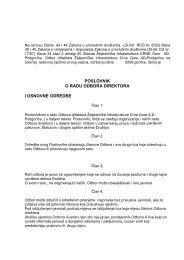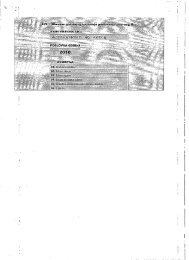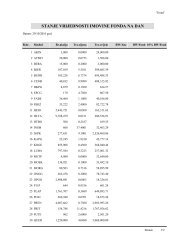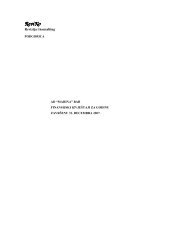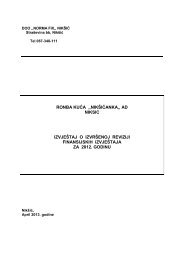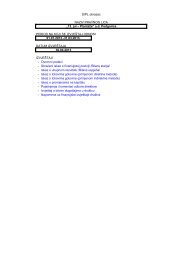Revizorski izvjestaj 2006 (pdf) - Montenegro berza
Revizorski izvjestaj 2006 (pdf) - Montenegro berza
Revizorski izvjestaj 2006 (pdf) - Montenegro berza
Create successful ePaper yourself
Turn your PDF publications into a flip-book with our unique Google optimized e-Paper software.
NOTES TO THE FINANCIAL STATEMENTS<br />
December 31, <strong>2006</strong><br />
CRNOGORSKA KOMERCIJALNA BANKA A.D., PODGORICA<br />
3. SUMMARY OF SIGNIFICANT ACCOUNTING POLICIES (Continued)<br />
3.5. Financial Assets (Continued)<br />
(c) Investments available-for-sale<br />
Available-for-sale investments are those intended to be held for an indefinite period of time,<br />
which may be sold in response to needs for liquidity or changes in interest rates, exchange rates or<br />
equity prices.<br />
(i) Initial recognition and subsequent measurement<br />
Purchases and sales of financial assets, held to maturity and available-for-sale are recognized on<br />
trade-date – the date on which the Bank commits to purchase or sell the asset. Loans are<br />
recognized when cash is advanced to the borrowers. Financial assets are initially recognized at fair<br />
value plus transaction costs for all financial assets not carried at fair value through profit or loss.<br />
Available-for-sale financial assets are subsequently carried at fair value. Loans and receivables<br />
and held-to-maturity investments are carried at amortized cost using the effective interest method.<br />
Gains and losses arising from changes in the fair value of available-for-sale financial assets are<br />
recognized directly in equity, until the financial asset is derecognized or impaired at which time<br />
the cumulative gain or loss previously recognized in equity should be recognized in profit or loss.<br />
However, interest calculated using the effective interest method is recognized in the income<br />
statement. Dividends on available-for-sale equity instruments are recognized in the income<br />
statement when the entity’s right to receive payment is established.<br />
The fair value of quoted investments in active markets is based on current bid prices. If the market<br />
for a financial asset is not active (and for unlisted securities), the Bank establishes fair value by<br />
using valuation techniques. These include the use of recent arm’s length transactions, discounted<br />
cash flow analysis and other valuation techniques commonly used by market participants.<br />
(d) Impairment of financial assets<br />
(i) Assets carried at amortized cost<br />
The Bank assesses at each balance sheet date whether there is objective evidence that a financial<br />
asset or group of financial assets is impaired. A financial asset or a group of financial assets is<br />
impaired and impairment losses are incurred if, and only if, there is objective evidence of<br />
impairment as a result of one or more events that occurred after the initial recognition of the asset<br />
(a ‘loss event’) and that loss event has an impact on the estimated future cash flows of the<br />
financial asset or group of financial assets that can be reliably estimated. Objective evidence that a<br />
financial asset or group of assets is impaired includes observable data that comes to the attention<br />
of the Bank about the following loss events:<br />
1 significant financial difficulty of the issuer or obligor;<br />
2. a breach of contract, such as a default or delinquency in interest or principal payments;<br />
3. the Bank granting to the borrower, for economic or legal reasons relating to the borrower’s<br />
financial difficulty, a concession that the lender would not otherwise consider;<br />
4. it becoming probable that the borrower will enter bankruptcy or other financial reorganization;<br />
10





